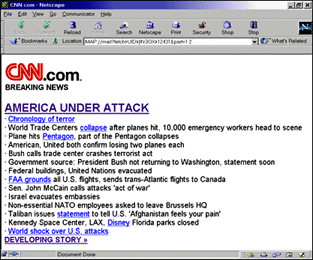- Related links
Back to basics

|
CNN's stripped-down site at approximately 1PM EST September 11, 2001. |
September 20, 2001 Last Tuesday, I could not bear to turn on the television and watch the raw broadcasts. Instead, I compulsively riffled across the web trying to piece together how and why and what was happening.
Information was scarce, datapipes overwhelmed. I flipped from bbc.co.uk to boston.com to cnn.com to nytimes.com occassionally finding a live web page with another shard of information.
To speed thruput, CNN quickly stripped its site of photos and graphics. I took a screenshot. As you can see from the attached jpeg, CNN distilled its coverage to a series of unrelated sentences, some containing a link to another nugget of information. The New York Times also jettisoned superfluous imagery, including ads.
It wasn't just our technological bandwidth that was overwhelmed. The Niagara Falls of information constantly blasted apart whatever vessels anyone held up to channel it. For news organizations, there was neither the time nor the strength for fancy graphics, editorial debates about explanatory boxes, pullquotes, or special logos.
The presentation we got was as close to being "unmediated" as media can get.
Thank God.
What we wanted was news, not media. Under the circumstances, we might have been insulted by anything too artful or pre-meditated. And, as we raced from URL to URL looking for a live server and another shard of news, who wanted to spare the time to decipher another web organization's inbred graphical logic or arcane iconography?
Nine days after those horrible events, the online media is back "on." Our news is once again finely sliced, polished and wedged into ornate jewel boxes.
The news is too often obscured by this craftsmanship.
The mind numbs quickly as it slogs through the web's myriad styles and rubrics looking for facts and new developments. This might be OK if one site could deliver it all. But unfortunately, there is still too much going on for any site to comprehend and digest. To get a decent ration of news, hungry readers have to scramble through the tangle of competing styles and strategies.
In retrospect, that first CNN page served us well. The top item was the most important or newest piece of news. No item received more space than the rest, since no one dared predict how it all fit together.
It is worth noting that the CNN page looks like a blog. Formerly (and formally) known as "the weblog," this style of web site is used increasingly by individuals to post short bursts of information with links to other sites or interesting articles.
Half diary, half reading list, the best blogs offer unadorned personal distillations of the Internet's blooming, buzzing, mass of confusion.
Blogs are becoming the clearinghouse of choice for sophisticated readers online. Journalist-turned-technologist Nick Denton noted in today's column in the Guardian that he now relies of blogs for news. Denton believes blogs have a unique knack for conveying "a wealth of information, a variety of opinion, and a subtlety of judgment."
I would go one small step further. I think the graphical simplicity and uniformity of blogs helps readers get what they want. We can learn a lot from blogs.
Henry Copeland in Paris, France.


